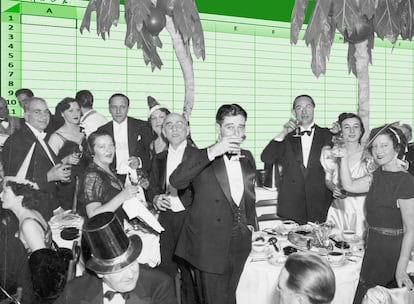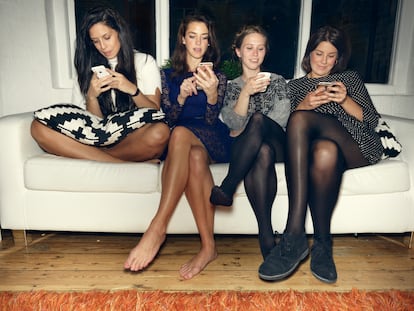Drinks, flirting and PowerPoint: How the worst of work culture is colonizing our time off
They began in 2012, gained popularity during the pandemic and today have established themselves as an actual nightlife option: parties with technological and professional themes that are asserting the influence of the office over human contact


One of the most memorable scenes in Sex and the City features a guest star, played by Kristen Johnston, who complains of how boring New York parties have become and seconds later, falls out a window. But that tiresome sensation is by no means exclusive to a single city: many believe that our concept of fun has been redefined, and that celebrations full of toasts and surging emotion are a thing of the past. Going out is no longer in style.
The reasons for the living room supplanting the dance floor? The epidemic of loneliness, which the World Health Organization has declared a “global public health concern.” That, in addition to the way that self-imposed confinement is erasing the increasingly thin line that separates work and home. The unexpected consequence of this fusion of the work and personal spheres? The triumph of PowerPoint parties, in which each attendee presents a presentation explaining a certain subject.
From the most bizarre topics found on a Subreddit to the range of deaths that can be experienced in a zombie apocalypse, all kinds of content fit into these events, seemingly sent to infect our free time with office tropes. Work appears to have phagocytized leisure time. In an article on the trend, The San Francisco Standard delivered a headline infused with a certain sense of humor: “The worst part of your job is a hot house party trend.”
It’s not an office party, it’s the office in a party
Javier Divieso, expert on leadership, teams and human resources, says that although these parties may appear to be an extension of work due to the fact that this kind of presentation is usually associated with the professional and academic worlds, that’s not the sense that their participants have of them. “Due to their playful intent, the creative freedom they impart and the social context in which they take place, participants see [PowerPoint parties] as a recreational activity. Therefore, far from perceiving these gatherings as an extension of work, for Generation Z, they are nothing more than a fun and creative way to connect with friends,” he says. “Younger generations were born into digital culture, and these PowerPoint parties are nothing more than a natural extension, using platforms and tools that they’ve already mastered for recreational and social purposes.”
This style of party was born in 2012, when three students from Canada’s University of Waterloo organized an event they called Drink, Talk & Learn, in which guests had to bring a presentation on a subject linked to video games. The arrival of the pandemic provided a pop to the gatherings due to their digital nature: they allowed every participant, from the safety of their home, to share their computer’s screen to keep the party going even when people couldn’t meet up in person.
“Many people in the [San Francisco] Bay Area have highly technical jobs, work from home and interact with few people over the course of a day.” And thus, the attraction to “boring party games, that let them share experiences that otherwise were isolated,” comments Zachary Reese, director of Love and Communication Lab, a center whose mission is to explore the complexities of interpersonal relationships, in The San Francisco Standard. The publication found that, sadly for Microsoft, the majority of these presentations aren’t held using PowerPoint. “PPT Parties can be carried out with any system, software or app. For me, it seems like just a strategy of Microsoft to squeeze more juice out of its well-known program. Or it’s merely a way of putting a twist on it, bringing up ideas and uses of PowerPoint, which is already famous in its own right around the world,” Sara Mompart, graphic designer, tells EL PAÍS.
Despite that fact that she’s never participated in this kind of party, nor has the intention of doing so, she knows about their existence from “having read about them on some message boards and designer sites.” She finds them strange, because far from being intuitive, “locating the buttons and menus to apply interesting solutions can turn into a nightmare.” Regarding the fun parts of such programs, she says that, “with good taste and aesthetic sense, the results are incredible. There’s a lot of things that can lend interactivity and dynamism to a PowerPoint: logo animation, use of 3D modeling, attractive transitions between photos, inserting videos,” she explains.
For its part, aware of the trend, Microsoft already offers guides to organizing this kind of party and has even created different templates with which to build presentations. “PowerPoint parties are a wonderful way to connect with friends, family or coworkers,” the company says. The hunt for “PowerPoint party ideas” offers subjects like “your friends if they were characters from The Office,” “a song to describe each person in your group of friends,” “things you’d do if you were president,” “your most unpopular opinions,” “your favorite celebrity couples” and “the best cafés in your city.” Doesn’t sound too bad, if it weren’t for having to spend time putting the thing together.
The home as leisure setting
The Spanish report Young people, leisure and technology. A look at the vital structure of youth through free time and tech finds that the primary change in leisure activities in recent years is the overwhelming incorporation of leisure that is conducted through technological tools. Dating apps have made it possible to find a partner without ever leaving the house, food delivery apps have precluded the need to go out to eat and streaming platforms have brought the movie theater into the bedroom. 74.6% of survey respondents said that the activity they do the most in their free time is chat and surf the internet, compared to 22.7% who responded that they spend more time going out at night.
The most relevant point here, from a historical perspective, is the drop in evening excursions, namely, going to bars, pubs and clubs. “The panorama of these changes appears to point to leisure that is taking place more and more through digital technology, and is increasingly taking place in the home,” say Elena Rodríguez San Julián and Juan Carlos Ballesteros Guerra, co-authors of the study.
Eduardo Vara, author of the Spanish language book Maldito trabajo (Damn job), warns that if PowerPoint parties involve the use of the same digital tools we utilize in the office, they’re not the healthiest of gatherings. “To disconnect and rest is as important as changing one’s environment when it comes to shifting our mental dynamic. For those who work at home on the computer, it would be much more interesting to plan leisure activities in technology-free spaces, preferably natural environments, where they can interact with others in the most relaxed and physical way possible,” he says.
There are even social gatherings that are organized like workshops, as in the case of one X user who posted about having organized “a VERY fun dinner party/group workshopping of my brother’s Hinge profile.”
“If we pay attention to the etymology of the (Spanish word for work) negocio, from the Latin nec-otium, that which is not leisure, it becomes clear that we are losing free time. Because, by making it profitable, we deny ourselves authentic spaces for disconnecting, where we can recover physically and mentally and where we can explore ourselves beyond our productivity. And, in addition, staying in work mode distorts the spontaneity and openness we need to build other non-work relationships that are important, like friendships. So, instead of seeking out friends to whom we can shed our professional impostures and show our vulnerability, we continue to strive to project a competitive image that will attract potential allies and partners,” Vara says.
There are even social media users who have become experts on the subject, like McCall Mirabella, who has nearly a million followers on TikTok, and who opted to ask attendees at her 21st birthday party for PowerPoint presentations rather than gifts. Sad? Leadership expert Divieso doesn’t think so. “For newer generations, these kinds of activities provide them with freedom and greater social connection. They also allow them to develop skills such as communication, creativity and critical thinking and to foster innovation and creativity. The consequences of not knowing how to disconnect can be negative and lead to burnout and stress. But in general, if we are able to find a balance, this kind of activity can bring significant benefits,” he says. Of course, there will always be those who prefer to go to the bar.
Had a VERY fun dinner party/group workshopping of my brother’s Hinge profile.
— Sheel Mohnot (@pitdesi) April 16, 2024
We debated prompts & responses, photos, & relative strength of matches, using 2 screens - 1 for photos & 1 for the profile.
Big diff bw men’s suggestions (with innuendo) and women’s (anti innuendo). pic.twitter.com/akouLxroin
Sign up for our weekly newsletter to get more English-language news coverage from EL PAÍS USA Edition
Tu suscripción se está usando en otro dispositivo
¿Quieres añadir otro usuario a tu suscripción?
Si continúas leyendo en este dispositivo, no se podrá leer en el otro.
FlechaTu suscripción se está usando en otro dispositivo y solo puedes acceder a EL PAÍS desde un dispositivo a la vez.
Si quieres compartir tu cuenta, cambia tu suscripción a la modalidad Premium, así podrás añadir otro usuario. Cada uno accederá con su propia cuenta de email, lo que os permitirá personalizar vuestra experiencia en EL PAÍS.
¿Tienes una suscripción de empresa? Accede aquí para contratar más cuentas.
En el caso de no saber quién está usando tu cuenta, te recomendamos cambiar tu contraseña aquí.
Si decides continuar compartiendo tu cuenta, este mensaje se mostrará en tu dispositivo y en el de la otra persona que está usando tu cuenta de forma indefinida, afectando a tu experiencia de lectura. Puedes consultar aquí los términos y condiciones de la suscripción digital.
More information
Archived In
Últimas noticias
More than 40 Democratic lawmakers urge Trump in a letter to stop his ‘attempts to undermine democracy in Brazil’
The journal ‘Science’ criticizes Trump’s anti-renewable energy policy: ‘The US is failing to benefit from its own innovations’
Cubans hope for a miracle as dengue and chikungunya spread
The long shadow of the father figure in the films of Rob Reiner
Most viewed
- Christian Louboutin: ‘Young people don’t want to be like their parents. And if their parents wear sneakers, they’re going to look for something else’
- Cartels in Mexico take a leap forward with narco-drones: ‘It is criminal groups that are leading the innovation race’
- ‘El Limones’ and the growing union disguise of Mexican organized crime
- Liset Menéndez de la Prida, neuroscientist: ‘It’s not normal to constantly seek pleasure; it’s important to be bored, to be calm’
- The low-cost creative revolution: How technology is making art accessible to everyone










































